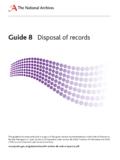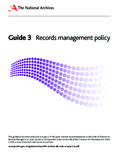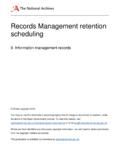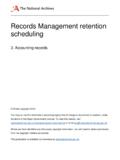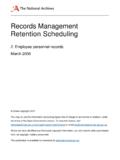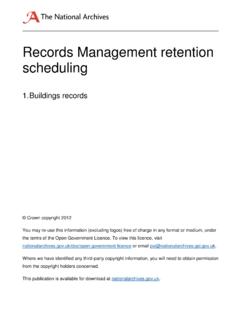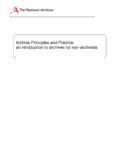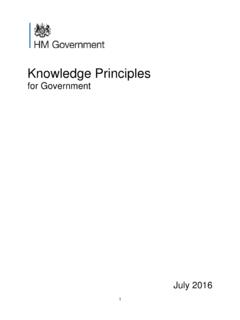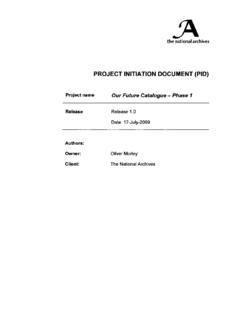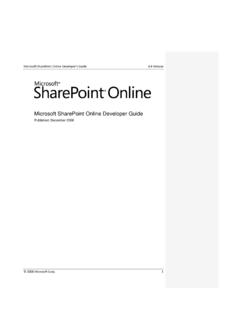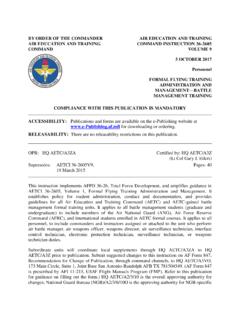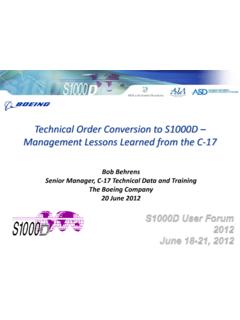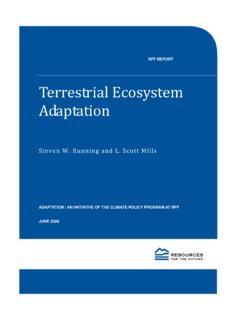Transcription of Managing digital records without an electronic …
1 Managing digital records without an electronic record management system Crown copyright 2012 You may re-use this information (excluding logos) free of charge in any format or medium, under the terms of the Open Government Licence. To view this licence, visit or email Where we have identified any third-party copyright information, you will need to obtain permission from the copyright holders concerned. This publication is available for download at Managing digital records without an electronic record management system Last updated June 2010 Page 2 of 58 Contents introduction .. 4 Purpose .. 4 Audience .. 5 Scope .. 6 Definitions .. 7 records management policy .. 10 What is a records management policy .. 10 How does the policy aid records management ? .. 11 Where can I learn more? .. 13 Filing structures .. 14 What is a filing structure .. 14 How does the filing structure aid records management ?
2 16 Constructing the filing structure .. 17 Where can I learn more? .. 21 management rules .. 22 What are management rules .. 22 Monitoring and maintenance of management rules .. 24 How do they aid records management ? .. 25 management of metadata .. 25 Types of management rules .. 28 Naming conventions .. 28 Version control for records .. 32 Format of dates .. 33 Where can I learn more? .. 34 Access control management .. 35 What are access controls? .. 35 Managing digital records without an electronic record management system Last updated June 2010 Page 3 of 58 Setting up access controls .. 37 How do access controls aid records management ? .. 38 Complex access control models .. 39 Monitoring access control allocations .. 39 Other access controls .. 40 Operational limitations .. 40 Where can I learn more? .. 40 Disposal policy and management .. 41 What is a disposal policy? .. 41 What is disposal management ?
3 41 How does disposal management aid records management ? .. 42 Where can I learn more? .. 44 Email management .. 44 What is email management ? .. 44 How does email management aid records management ? .. 45 management for rules for email .. 46 Guidance for email management .. 47 Email formats .. 47 Retaining emails within the email client .. 49 Alternative email storage .. 52 Bulk email archive storage .. 52 Bulk email archive file format .. 53 Where can I learn more? .. 53 Integrating management of paper records .. 54 Where can I learn more? .. 55 Further reading .. 57 Managing digital records without an electronic record management system Last updated June 2010 Page 4 of 58 introduction Managing electronic records presents a significant challenge for an organisation of any size or sector. For those that store their records in file systems (including shared drives), which have no formal controls in place, the risk of alteration or deletion makes this challenge even greater.
4 Organisations may have a well maintained paper records system but this is not necessarily appropriate as a template for Managing electronic records . This is because of the volume of electronic records , and variety of file formats, combined with the ease of creation. electronic records management needs to be very carefully considered and structured to ensure the integrity of the records is not compromised upon capture and they remain retrievable for as long as they are required. Purpose The purpose of this guidance is to demonstrate how an organisation can improve the management of records within their file systems by: establishing a records management policy creating management rules and using them developing a classification structure introducing email management rules and version control establishing user compliance or buy-in without these an organisation is at risk of failing to manage records exposing them to risks including reduced business efficiency or potential legal action.
5 An organisation in control of its records can begin to realise significant benefits including: improved business efficiency and effective use of IT resources structured management of records retained for legal and regulatory purposes support of accurate capture and management of electronic records (irrespective of format) into the file system access to records to enable informed and effective decision making Managing digital records without an electronic record management system Last updated June 2010 Page 5 of 58 retention of a corporate memory of transactions, decisions and actions taken by, or on behalf of, the organisation protection of the rights and interests of the organisation (and others) who the organisation retains records about protection of the characteristics of records as defined by ISO 15489, particularly their reliability, integrity and usability1 identification of records required for permanent preservation and archive Throughout this guidance there are examples using Microsoft Windows XP and Office 2007 (with Outlook).
6 However this guidance is not limited to users of this platform and software applications and should be equally relevant to users of any desk based operating systems and office software applications. This guidance replaces records management guidance previously published by the Historical Manuscripts Commission, and guidance on Managing records in Office 97 published by the Public record Office. Audience This guidance is intended for anyone who controls the management of records within any organisation or part of an organisation. This may be a formally adopted records management role, but it also includes those who manage records as part of their role such as medical or legal secretaries. Smaller organisations, which do not have formal records management , can use this guidance to create a full programme for improving records management . Larger organisations, which already have some form of records management , can use this document to develop records management where there needs to be significant consultation and development work.
7 1 digital Continuity advice and Guidance from The National Archives is available where long term maintenance is a requirement. This guidance is principally provided for public authorities and addresses the equivalent long term issues of loss of completeness, availability and usability Managing digital records without an electronic record management system Last updated June 2010 Page 6 of 58 This guidance is not restricted to any particular sector or industry. References to specific guidance are given as indicators of best practice in records management . Each organisation needs to consider its regulatory and legal environment which may dictate specific decisions regarding access and disposal of records . Public authorities should read this guidance in conjunction with the records management Code of Practice revised and reissued under s 46 Freedom of Information Act, 2000.
8 Useful references to sections of The records management Code have been included in Where can I learn more? where appropriate. Scope The focus of this guidance is the management of records stored within a file system using existing infrastructures and resources. It will discuss the process of defining an organisation s need for records management based on the development of a policy and supporting guidelines for users. Other types of basic content services that offer some form of collaboration and informal document management might be used, such as Microsoft Office Sharepoint or Alfresco. They are not referred to in detail in this guidance. Such applications may support a subset of record management activities but an organisation still needs to develop and implement clear policies and management rules that will build an identifiable records management culture. These products are rarely coded to implement records management rules without significant customisation and organisations should develop appropriate rules.
9 They should evaluate solutions to support their implementation, Managing the risk of records management failures. It may be that the procedures described in this guidance are preferable or alternatively that there is a clear case for deploying a records management application (or ERMS). This guidance is not intended to be used as a technical manual, nor does it provide an organisation with a full set of policies and management rules. Use the guidance as a basis for best practice in the most suitable manner for their organisation. Managing digital records without an electronic record management system Last updated June 2010 Page 7 of 58 Inevitably there will be some technical discussion. This will be restricted to a level of understanding that enables the reader to discuss technical issues with IT or records management specialists where required. The examples will use Microsoft Windows application suite (including Microsoft Outlook), and are for illustrative purposes only.
10 The guidance will not discuss use of content management systems nor website management tools. In practice, organisations will be Managing both paper and electronic records concurrently for a significant period of time. This guidance contains information on how the relationship between the two types of record may be managed. It offers guidance on the management of physical records within an integrated environment but it does not extend to examining systems or applications (specifically for Managing physical records such as a library system or tracking system which do not allow for accurate management of electronic records ). There is further advice on this topic in a related piece of guidance Identifying and specifying requirements for offsite storage of physical records . Definitions This guidance uses some terms in a specific way: Aggregation record assemblies existing within a filing structure (groups of folders) or a folder containing records .
